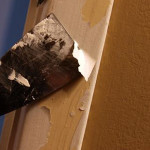Why does my paint not cover the wall surface?
Check to make sure you are using the proper roller cover. The type of roller cover that should be used is usually specified on the can of paint. It can make a significant difference and save money by avoiding the cost of having to apply a 2nd coat of paint.
Application technique is important for an even solid coating. Apply the paint in an “N” fashion on the upper portion of the wall and then apply a second “N” pattern on the bottom of the wall. Now go back and lightly roll over while the paint is still wet from floor to ceiling to smooth out and even the application. Another roller application technique used by professionals is to apply a roller full to the wall about 6 inches above the baseboard and roll up to within 6 inches of the ceiling. Roll through this area two or three times and then begin to extend the paint up toward the ceiling cut-in line then roll down to the bottom and extend the paint down to the baseboard cut-in. The next roller full again starts at 6 inches above the baseboard and rolls up to within 6 inches of the ceiling overlapping the first roller coating by 50%. After three roller fulls have been applied and extended up to the ceiling cutline and down to the baseboard cutline, lightly smooth all three applications. Now begin the next section overlapping 50% of the previous roller application. When the next three roller applications have been completed lightly smooth the wet paint of the last three roller applications. This will produce a very even and smooth wall surface with no roller marks and no thin spots.
Good coverage can also be affected by the quality of roller frame. If it is too flimsy it will produce a different texture and thickness on one side of the roller cover. A quality frame is sturdier and will not bend on the side of the roller cover that is away from the frame. It will produce an even texture.
Of course, the higher the quality of the paint the better the coverage will be. Lower quality paint does not have the ingredients and quality of pigments necessary for great coverage.
With quality paint a large number of colors will cover over another color with one coat. You can end up spending more with low quality paint because it will probably require two coats. A common homeowner mistake to be avoided is to spread the paint too thin. Put on a good solid even coat. Do not try to stretch the paint too far.
How do I avoid roller marks and excessive texture when rolling my walls?
These problems usually occur on the wall surface when care is not taken to lightly smooth the paint during the application process. Pressing too hard on the roller will cause roller marks or tracks. You can also get a stipple effect or heavy texture on the wall surface if you are using the wrong roller cover or if the quality of the paint is poor. Lower quality paints have a tendency to dry quicker and do not allow the paint to stay wet long enough to lay flat. To avoid this problem lightly roll over the surface while the paint is still wet until no roller marks remain.






